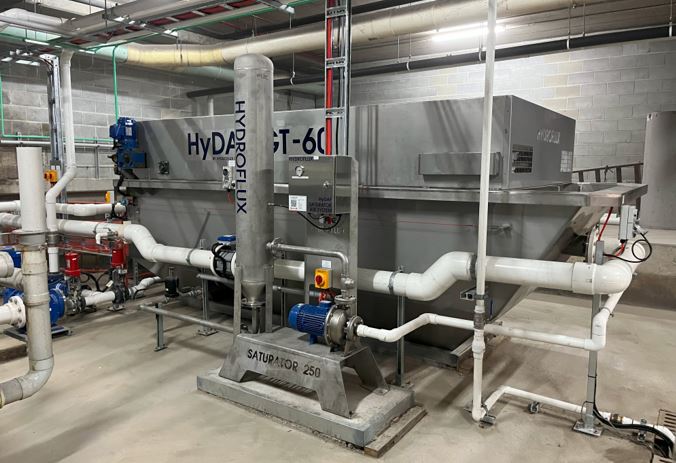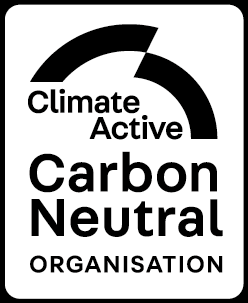
Food Court DAF Systems
Futureproof your Shopping Centre Wastewater Treatment Plant by Installing a Hydroflux GT-DAF
Centralised wastewater treatment for commercial kitchens in shopping center food courts is not only a regulatory requirement in some regions but also offers significant advantages over the operation of traditional grease traps. Replacing multiple grease traps with a Dissolved Air Flotation (DAF) system enhances treatment efficiency, and ensures long-term compliance with environmental regulations—future-proofing your facility.
The Hydroflux GT DAF is an innovative solution designed specifically to remove grease, oils, and solids from commercial kitchen wastewater. It features a smaller footprint than traditional DAF systems and operates with nearly half the energy consumption.
Hydroflux partners with builders, plumbers, hydraulic engineers, and end users alike from concept to completion. We offer technical advice, flexible designs, supply and installation packages, and a methodological approach to problem-solving. Some of our satisfied customers include:




Why install the Hydroflux GT-DAF instead of grease traps?
In high-density areas like shopping centers, where space and cost efficiency are critical, the use of Dissolved Air Flotation (DAF) systems offers substantial advantages. For a new or redeveloped shopping center requiring say 6 x 5000 L grease traps, switching to a single GT DAF system can reduce the space requirement by more than 75%. This considerably smaller footprint of the DAF system allows for more flexible use of the available space, potentially freeing up valuable real estate for other commercial purposes.
Furthermore, by consolidating multiple grease traps into a single, efficient system, the center can reduce maintenance costs and minimise the cost and complexity of grease management. Over the long term, the DAF system also enhances the effectiveness of the pretreatment processes and helps future-proof the shopping center, supporting its growth and operational efficiency for years to come.
In summary, centralised treatment with a GT DAF system offers several key benefits:
- All wastewater treated in a single location: This centralisation simplifies management and monitoring, improving operational efficiency and saves space
- Significant reduction in sludge pumping: Only the separated grease is removed off-site by tanker, eliminating the requirement for frequent managed grease trap pumps outs
- Flexible grease off-loading: The option to install the grease off-loading facility remotely from the treatment plant adds versatility in space planning and logistics
- Improved performance over traditional grease traps: The DAF system provides a far more efficient grease separation, reducing the likelihood of downstream pipe blockages and improving overall wastewater quality
- Easy upgrade for demulsification: The system can be upgraded to include demulsification of solubilised grease when required, ensuring better performance as regulations tighten.
These advantages make centralised treatment using DAF systems a highly efficient and adaptable solution, capable of meeting both current needs and future regulatory changes.
What makes the Hydroflux GT DAF the preferable solution for Food Courts?
The GT-DAF system is a unique two-stage separation device designed exclusively for the treatment of greasy wastewater from food courts and other retail complexes. It is based on an enhanced flotation design that offers many benefits over using traditional DAF systems.
When wastewater enters the Hydroflux GT-DAF, it firstly passes through a unique laminar zone where free grease and solids are separated under gravity prior to the addition of the dissolved air recycle stream. This prior separation prevents wasting dissolved air on readily separable solids and grease and greatly reduces the size of the dissolved air saturation system. This enables the GT-DAF to use less than half the power of traditional DAF systems and reduce the footprint by over 30%.
- A submerged high-level inlet with overflow ensures that upstream pipework is not subject to possible blockages that could cause flooding
- A specially designed hopper base to allow automatic de-sludging of the system without full draining
- Designed with solid guarding to prevent splashing during clean down
- Unique integrated demulsification process to enhance grease removal can be retrofitted when required
- Fully internally welded stainless steel construction

Capacities
The GT-DAF system is designed to cover the flows from the smallest food courts to the largest shipping complexes in Australia.
| GT-DAF Model Number | Treatable Flow Range (KL/Hr) | Equivalent Grease Trap Volume |
| GT10 | 10 | 10,000 – 20,000L |
| GT30 | 30 | 20,000 – 50,000L |
| GT60 | 60 | 50,000 – 90,000L |
| GT90 | 90 | 90,000 – 120,000L |
Contact us for drawings and additional technical details.
Benefits of Pre-Screening Wastewater
While not mandatory, pre-screening is highly beneficial as it removes large objects such as vegetables and occasionally cutlery from the wastewater before it enters the DAF system. Without screening, these objects can cause blockages in the drainage system or lead to more frequent cleaning of the DAF tank.
To address the greasy nature of the wastewater, Hydroflux utilises internally fed rotary screens equipped with a hot water sparge for automated cleaning. The screened material is macerated and pumped to the sludge tank for disposal. Without this secondary maceration process, additional waste solids handling would be required, which is both difficult to manage and likely to generate unpleasant odors.



GT-DAF FAQs
Yes, the GT-DAF system is designed to handle variable flows efficiently. Hydroflux has collected extensive data on wastewater flow rate variations from food courts, which is used to determine the system’s capacity during the design and selection process. The system’s capacity is always based on peak flow, with additional contingency for future expansion. Importantly, the GT-DAF system maintains consistent performance across the entire range of flows, ensuring that even at low flows, operation is not compromised. The ideal installation scenario is one where wastewater from all facilities is directed to the system by gravity, allowing it to accept whatever flow is received however where necessary, wastewater can be delivered to the DAF from one or multiple pump stations.
,
Dosing of chemicals into the wastewater upstream of the GT-DAF will improve the performance, however, currently this is not a requirement with most water authorities in Australia. We can assist you with determining the discharge requirements for your region and determine if chemical dosing is required.
All GT-DAF systems are designed and fitted with chemical injection points to safeguard possible future tighter water quality requirements that may be imposed by Water Authorities
The amount of sludge removed by the GT-DAF system depends on the level of solids and grease discharged into the drains. It is far more economical to remove solids and grease at the source rather than allowing them to discharge into the drain. Hydroflux will advise and train center management in best practices for cleaning at restaurants, as significant operational savings can be achieved by implementing proper cleaning procedures.
Unlike a grease trap, the GT-DAF system continuously removes grease and solids, which are transferred to a storage tank. This is one of the key differences between installing a GT-DAF and a grease trap, as only sludge is removed from the site, rather than removing both water and sludge from a grease trap. Based on experience, the DAF system typically generates sludge at a rate of 1-2% of the flow. This sludge will need to be pumped out from the storage tanks and removed from the site in a manner similar to how grease traps are pumped out.
Unlike a grease trap, the GT-DAF system continuously removes grease and solids, ensuring its performance remains consistent over time. Some solids will accumulate at the base of the system, which will require occasional pumping. The grease and sludge are stored in a secondary vessel, equipped with a high-level alarm. When this vessel is full, it must be pumped out, a service that can be provided by a grease trap contractor, as it is treated as grease trap waste.
The system can often be maintained by in-house personnel. Hydroflux can offer a service and preventative maintenance program if required. It is strongly advisable to have hot water available for cleaning as it is much easier to clean greasy surfaces with hot water than cold water and for this reason, Hydroflux will generally include a suitably sized hot water system as part the scope. Also it is good practice to periodically flush areas where grease accumulates. The GT-DAF system is fitted with dedicated spray bars and flushing points for this purpose.
A typical GT DAF room is shown below. Typically a 40-45 m2 is adequate for the installation of all components

Design and Construct Capabilities
The GT-DAF system is one key component within a comprehensive wastewater treatment solution, supported by ancillary processes such as sludge handling, automation, and control. Hydroflux offers flexible contract options, ranging from equipment design and supply to full turnkey installations.
With a team of qualified civil, mechanical, chemical, and electrical engineers, as well as experienced project managers, site supervisors, commissioning engineers, and service technicians, Hydroflux ensures expert execution at every stage. Our offices across Australia provide a strong local presence, ensuring seamless project management from design through to installation. Additionally, Hydroflux offers post-installation routine service contracts to maintain system performance and longevity.
Sustainable Solutions
As Australia’s first certified carbon-neutral water and wastewater chemical supply and service business, we focus on sustainability. Developing and delivering sustainable solutions for treatment plant operation and maintenance is at the core of what we do. Our equipment is the most sustainable in the Australian and New Zealand market and is also carbon-neutral. Click here to find out what this means for you.

